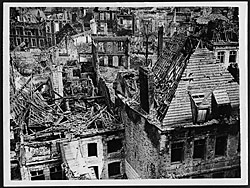
Unit 5: Crisis and Change
Lesson B: Global Effects of a Total War
Lesson Overview
After decades of growing rivalries, tense alliances, increasing nationalism, and expanding militaries in Europe, World War I exploded into a global conflict in 1914. Although both sides believed the war would be over quickly, the war dragged on until 1918, when it concluded with an armistice. On November 11, 1918, the Allies and Central Powers signed an armistice, or agreement, to stop fighting.
"The Great War" was unlike any war ever fought and was one of the most devastating conflicts in history in terms of both economic and human costs. New technologies and advances in weaponry led to devastation on a scale never seen before. Nearly ten million soldiers died in the conflict. Total war took the lives of millions of civilians, too, as battles spread into cities and farmland, causing famine and disease. All told, nearly 37 million people died worldwide as a result of World War I.
The war also took a toll on Europe's economy. The countries of Europe had emptied their treasuries. Survivors of World War I experienced a deep sense of despair, but were also hopeful that they could build a new, lasting peace.
Key Questions
- Why did World War I become a global war?
- How did technology change the nature of war in World War I?
- What was the human cost of World War I?
- What were the immediate social, political, and economic effects of "The Great War"?
- What were the goals of the Treaty of Versailles, and why did it fail?
- How did the Treaty of Versailles lead to nationalist struggles in Asia, Africa, and the Middle East?
Student Outcomes
- Describe the major turning points of the war and the principal theaters of conflict in Europe, the Middle East, Sub-Saharan Africa, East Asia, and the South Pacific.
- Analyze how scientific and technological inventions impacted the course of World War I, including the impact on civilian populations through "total warfare" and the impact on military personnel through trench warfare.
- Describe the outcomes of the Conference at Versailles, including the Treaty of Versailles, the creation of the League of Nations, and the development of the mandate system.
- Explain how the collapse of the German, Austrian, and Ottoman empires led to the eventual creation of new states in Europe and the Middle East, such as Yugoslavia, Turkey, and Transjordan.
- Explain how the mandate system altered patterns of European colonial rule in Africa and the Middle East and led to other nationalist struggles for independence.
- Explain how colonial peoples, such as those in South Asia, Africa, and the Middle East, contributed to the war efforts of both the Allies and the Central Powers by providing military forces and supplies.
- Analyze how the Russian Revolution and the entry of the United States affected the course and outcome of the war.
- Analyze cause-and-effect relationships and multiple causation, including the importance of the individual and the influence of ideas. (Historical Thinking Skill)
Key Terms
- armistice
- blockade
- doughboys
- isolationist
- League of Nations
- mandates
- pandemic
- reparations
- stalemate
- total war
- Treaty of Versailles
- trench warfare
Student Resources
- Global War Timeline (doc)
- Global War Extension Activity (doc)
- Total War (doc)
- Treaty of Versailles Organizer (doc)
- World War I - Total War Constructed Response (CR) (doc)
- Historical Investigation - Reactions to the Treaty of Versailles (doc)
Chart of Activities
| Activities to Complete | Estimated Time |
|---|---|
| Pre-Assessment | 5 minutes |
| Key Terms | 10 minutes |
| Activator: The World 1914-1918 | 5 minutes |
| Opening: Timeline of WWI 1914-1918 | 10 minutes |
| Activity 1: Industry and Imperialism - Secret Weapons of WWI | 10 minutes |
| Activity 2: The Great War - Theatres of War | 20 minutes |
| Activity 3: The United States Joins the War | 15 minutes |
| Activity 4: Total War and Civilians - Patriotism | 15 minutes |
| Activity 5: Total War and Civilians - Suffering | 15 minutes |
| Activity 6: Total War | 30 minutes |
| Activity 7: The Treaty of Versailles - A Plan for Peace | 20 minutes |
| Review and Assessment | 30 minutes |
| Lesson Summary | 5 minutes |
Lesson Completion Time
The total estimated time to complete this lesson is 190 minutes.
Page Notes:
[1] Source: This image from http://www.flickr.com/photos/nlscotland/4700492416/ belongs to the National Library of Scotland's photostream with no known restrictions.



